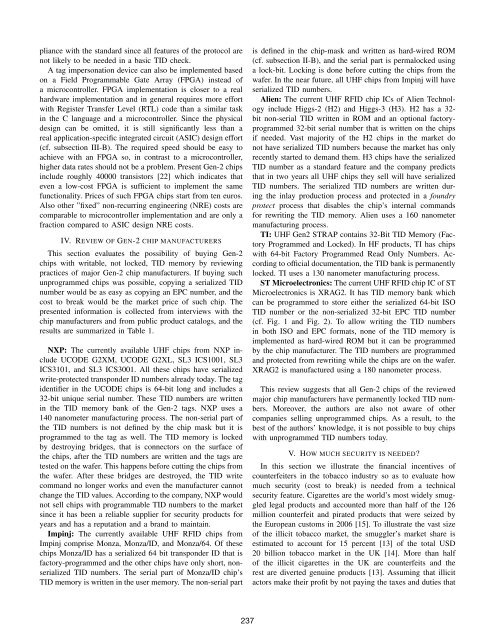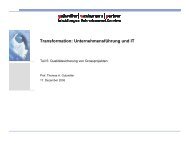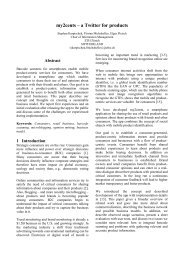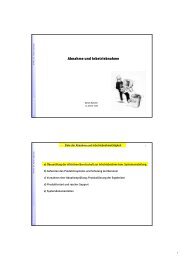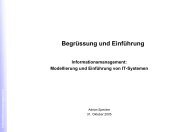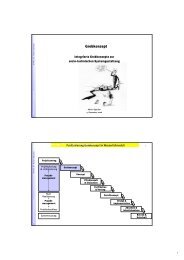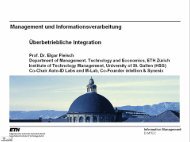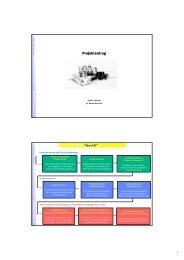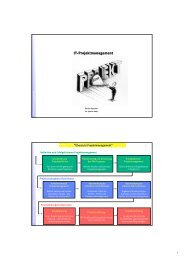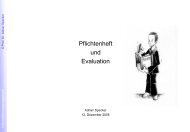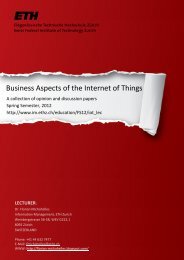Serialized TID numbers - Information Management - ETH Zürich
Serialized TID numbers - Information Management - ETH Zürich
Serialized TID numbers - Information Management - ETH Zürich
Create successful ePaper yourself
Turn your PDF publications into a flip-book with our unique Google optimized e-Paper software.
pliance with the standard since all features of the protocol are<br />
not likely to be needed in a basic <strong>TID</strong> check.<br />
A tag impersonation device can also be implemented based<br />
on a Field Programmable Gate Array (FPGA) instead of<br />
a microcontroller. FPGA implementation is closer to a real<br />
hardware implementation and in general requires more effort<br />
with Register Transfer Level (RTL) code than a similar task<br />
in the C language and a microcontroller. Since the physical<br />
design can be omitted, it is still significantly less than a<br />
real application-specific integrated circuit (ASIC) design effort<br />
(cf. subsection III-B). The required speed should be easy to<br />
achieve with an FPGA so, in contrast to a microcontroller,<br />
higher data rates should not be a problem. Present Gen-2 chips<br />
include roughly 40000 transistors [22] which indicates that<br />
even a low-cost FPGA is sufficient to implement the same<br />
functionality. Prices of such FPGA chips start from ten euros.<br />
Also other ”fixed” non-recurring engineering (NRE) costs are<br />
comparable to microcontroller implementation and are only a<br />
fraction compared to ASIC design NRE costs.<br />
IV. REVIEW OF GEN-2 CHIP MANUFACTURERS<br />
This section evaluates the possibility of buying Gen-2<br />
chips with writable, not locked, <strong>TID</strong> memory by reviewing<br />
practices of major Gen-2 chip manufacturers. If buying such<br />
unprogrammed chips was possible, copying a serialized <strong>TID</strong><br />
number would be as easy as copying an EPC number, and the<br />
cost to break would be the market price of such chip. The<br />
presented information is collected from interviews with the<br />
chip manufacturers and from public product catalogs, and the<br />
results are summarized in Table 1.<br />
NXP: The currently available UHF chips from NXP include<br />
UCODE G2XM, UCODE G2XL, SL3 ICS1001, SL3<br />
ICS3101, and SL3 ICS3001. All these chips have serialized<br />
write-protected transponder ID <strong>numbers</strong> already today. The tag<br />
identifier in the UCODE chips is 64-bit long and includes a<br />
32-bit unique serial number. These <strong>TID</strong> <strong>numbers</strong> are written<br />
in the <strong>TID</strong> memory bank of the Gen-2 tags. NXP uses a<br />
140 nanometer manufacturing process. The non-serial part of<br />
the <strong>TID</strong> <strong>numbers</strong> is not defined by the chip mask but it is<br />
programmed to the tag as well. The <strong>TID</strong> memory is locked<br />
by destroying bridges, that is connectors on the surface of<br />
the chips, after the <strong>TID</strong> <strong>numbers</strong> are written and the tags are<br />
tested on the wafer. This happens before cutting the chips from<br />
the wafer. After these bridges are destroyed, the <strong>TID</strong> write<br />
command no longer works and even the manufacturer cannot<br />
change the <strong>TID</strong> values. According to the company, NXP would<br />
not sell chips with programmable <strong>TID</strong> <strong>numbers</strong> to the market<br />
since it has been a reliable supplier for security products for<br />
years and has a reputation and a brand to maintain.<br />
Impinj: The currently available UHF RFID chips from<br />
Impinj comprise Monza, Monza/ID, and Monza/64. Of these<br />
chips Monza/ID has a serialized 64 bit transponder ID that is<br />
factory-programmed and the other chips have only short, nonserialized<br />
<strong>TID</strong> <strong>numbers</strong>. The serial part of Monza/ID chip’s<br />
<strong>TID</strong> memory is written in the user memory. The non-serial part<br />
is defined in the chip-mask and written as hard-wired ROM<br />
(cf. subsection II-B), and the serial part is permalocked using<br />
a lock-bit. Locking is done before cutting the chips from the<br />
wafer. In the near future, all UHF chips from Impinj will have<br />
serialized <strong>TID</strong> <strong>numbers</strong>.<br />
Alien: The current UHF RFID chip ICs of Alien Technology<br />
include Higgs-2 (H2) and Higgs-3 (H3). H2 has a 32-<br />
bit non-serial <strong>TID</strong> written in ROM and an optional factoryprogrammed<br />
32-bit serial number that is written on the chips<br />
if needed. Vast majority of the H2 chips in the market do<br />
not have serialized <strong>TID</strong> <strong>numbers</strong> because the market has only<br />
recently started to demand them. H3 chips have the serialized<br />
<strong>TID</strong> number as a standard feature and the company predicts<br />
that in two years all UHF chips they sell will have serialized<br />
<strong>TID</strong> <strong>numbers</strong>. The serialized <strong>TID</strong> <strong>numbers</strong> are written during<br />
the inlay production process and protected in a foundry<br />
protect process that disables the chip’s internal commands<br />
for rewriting the <strong>TID</strong> memory. Alien uses a 160 nanometer<br />
manufacturing process.<br />
TI: UHF Gen2 STRAP contains 32-Bit <strong>TID</strong> Memory (Factory<br />
Programmed and Locked). In HF products, TI has chips<br />
with 64-bit Factory Programmed Read Only Numbers. According<br />
to official documentation, the <strong>TID</strong> bank is permanently<br />
locked. TI uses a 130 nanometer manufacturing process.<br />
ST Microelectronics: The current UHF RFID chip IC of ST<br />
Microelectronics is XRAG2. It has <strong>TID</strong> memory bank which<br />
can be programmed to store either the serialized 64-bit ISO<br />
<strong>TID</strong> number or the non-serialized 32-bit EPC <strong>TID</strong> number<br />
(cf. Fig. 1 and Fig. 2). To allow writing the <strong>TID</strong> <strong>numbers</strong><br />
in both ISO and EPC formats, none of the <strong>TID</strong> memory is<br />
implemented as hard-wired ROM but it can be programmed<br />
by the chip manufacturer. The <strong>TID</strong> <strong>numbers</strong> are programmed<br />
and protected from rewriting while the chips are on the wafer.<br />
XRAG2 is manufactured using a 180 nanometer process.<br />
This review suggests that all Gen-2 chips of the reviewed<br />
major chip manufacturers have permanently locked <strong>TID</strong> <strong>numbers</strong>.<br />
Moreover, the authors are also not aware of other<br />
companies selling unprogrammed chips. As a result, to the<br />
best of the authors’ knowledge, it is not possible to buy chips<br />
with unprogrammed <strong>TID</strong> <strong>numbers</strong> today.<br />
V. HOW MUCH SECURITY IS NEEDED?<br />
In this section we illustrate the financial incentives of<br />
counterfeiters in the tobacco industry so as to evaluate how<br />
much security (cost to break) is needed from a technical<br />
security feature. Cigarettes are the world’s most widely smuggled<br />
legal products and accounted more than half of the 126<br />
million counterfeit and pirated products that were seized by<br />
the European customs in 2006 [15]. To illustrate the vast size<br />
of the illicit tobacco market, the smuggler’s market share is<br />
estimated to account for 15 percent [13] of the total USD<br />
20 billion tobacco market in the UK [14]. More than half<br />
of the illicit cigarettes in the UK are counterfeits and the<br />
rest are diverted genuine products [13]. Assuming that illicit<br />
actors make their profit by not paying the taxes and duties that<br />
263 237


